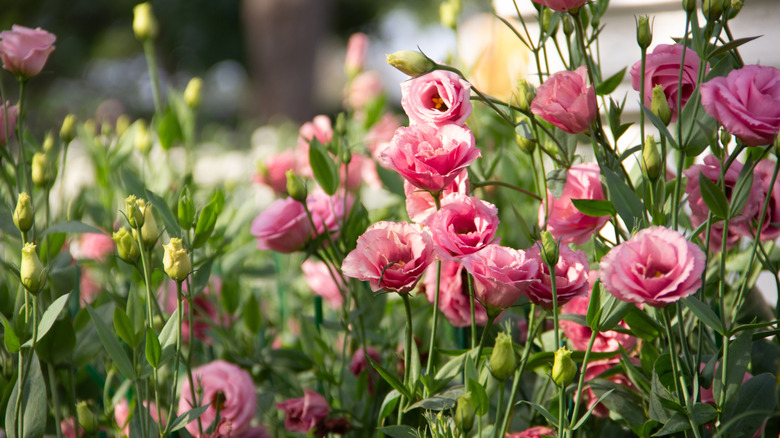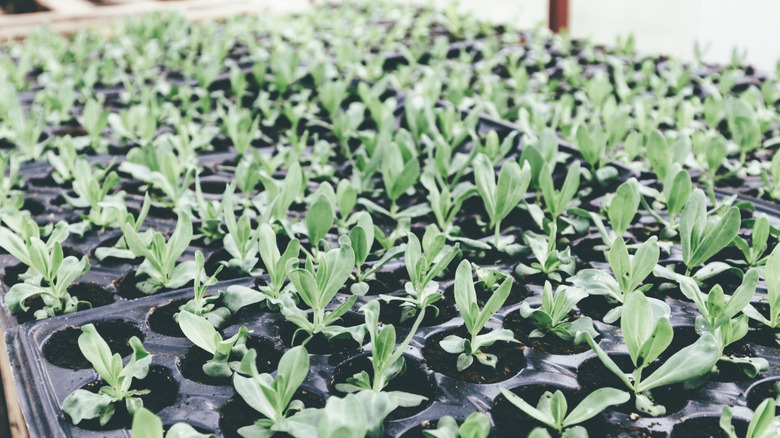The Rose-Like Flower You Don't Want To Grow From Seed
Just before spring arrives, enthusiastic gardeners around the country are putting down seeds of different flowers to ensure the little plants are ready to go out into the yard once the soil is warm enough and temperatures are starting to rise. Growing from seed is a great way to get lots of pretty blooms to add to your garden because they're fairly inexpensive and you can utilize some of the supplies you already have on hand. There are even lots of easy-to-grow perennial flower seeds if you don't have a green thumb. But, there are some species that you really don't want to grow from seed for various reasons. One of these is a stunning rose-like, deer-resistant flowering plant commonly known as lisianthus (Eustoma grandiflorum), prairie gentian, or 'Texas bluebell.'
Lisianthus is a beautiful flowering biennial with the most delightful showy blooms that look just like roses. While it can survive winter in USDA hardiness zones 8 through 10, it's more commonly grown as an annual in other regions. There are many reasons why this beauty is so difficult to grow from seed. The seeds have specific light and moisture requirements that you'll have to meet. Temperature also plays a vital role in the development of the seedlings, which means you may have to wait longer than you want for the plants to finally bloom. You should also consider the age of the seeds as this can benefit or hinder your results.
Lisianthus seeds have specific light and moisture needs
Unless you're ready for a challenge, it's far better to purchase lisianthus flowers as plugs rather than growing them from seed. The seeds can be quite difficult to germinate unless you can provide them with ideal conditions. Firstly, they need light to sprout, so it's important not to cover them with soil. This means you'll have to stop the tiny seeds from drying out by misting them multiple times a day with water. While covering the pots or seedling trays with a plant cloche will provide more moisture control, it won't prevent the surface of the soil from drying out.
A plant cloche works just like a miniature greenhouse. It creates a temperature and moisture-controlled environment directly above the soil by collecting the moisture that evaporates from the surface and holding it within the cover. This can be beneficial for the tiny sprouts as they start to poke their heads through the soil surface. However, it's still essential that you check the surface moisture regularly and mist when it looks dry to ensure that the seeds are constantly in contact with damp soil for effective germination. Seed age is also an important consideration because, while fresh seeds have relatively good germination rates, this will start to decline significantly as they age. This means you'll need to source your seeds from a reputable supplier to ensure they're as fresh as possible.
The importance of temperature when growing lisianthus from seed
Optimum seedling development for lisianthus flowers gets even trickier when it comes to maintaining the correct temperature. Even though the seeds may only take 10 to 14 days to germinate, it can take around six months or even longer for the plants to finally bloom, depending on the temperature you provide them with during their early growth stage. If you're trying to grow these plants as annuals, you'll want to ensure a temperature between 70 to 75 degrees Fahrenheit. This will probably mean that you'll have to put the little seedlings under a grow light. But beware — if the temperature rises to around 85 degrees Fahrenheit, the seedlings will form a rosette and develop as biennials, which means they're not going to flower until the second year. Unless you live in zones 8 through 10, this is not what you want because the plants are most likely not going to survive through the winter in your garden, and you'll have to start all over again with a new batch.
As you can see, you'll need patience, perseverance, and commitment to ensure successful germination and subsequent flowering. That's precisely why you don't really want to grow these plants from seed if you don't have to. However, lisianthus is still a beautiful addition to your garden. For example, if you struggle to keep peonies alive, lisianthus is a stunning alternative, especially if you can get your hands on some healthy ready-to-plant plugs.


